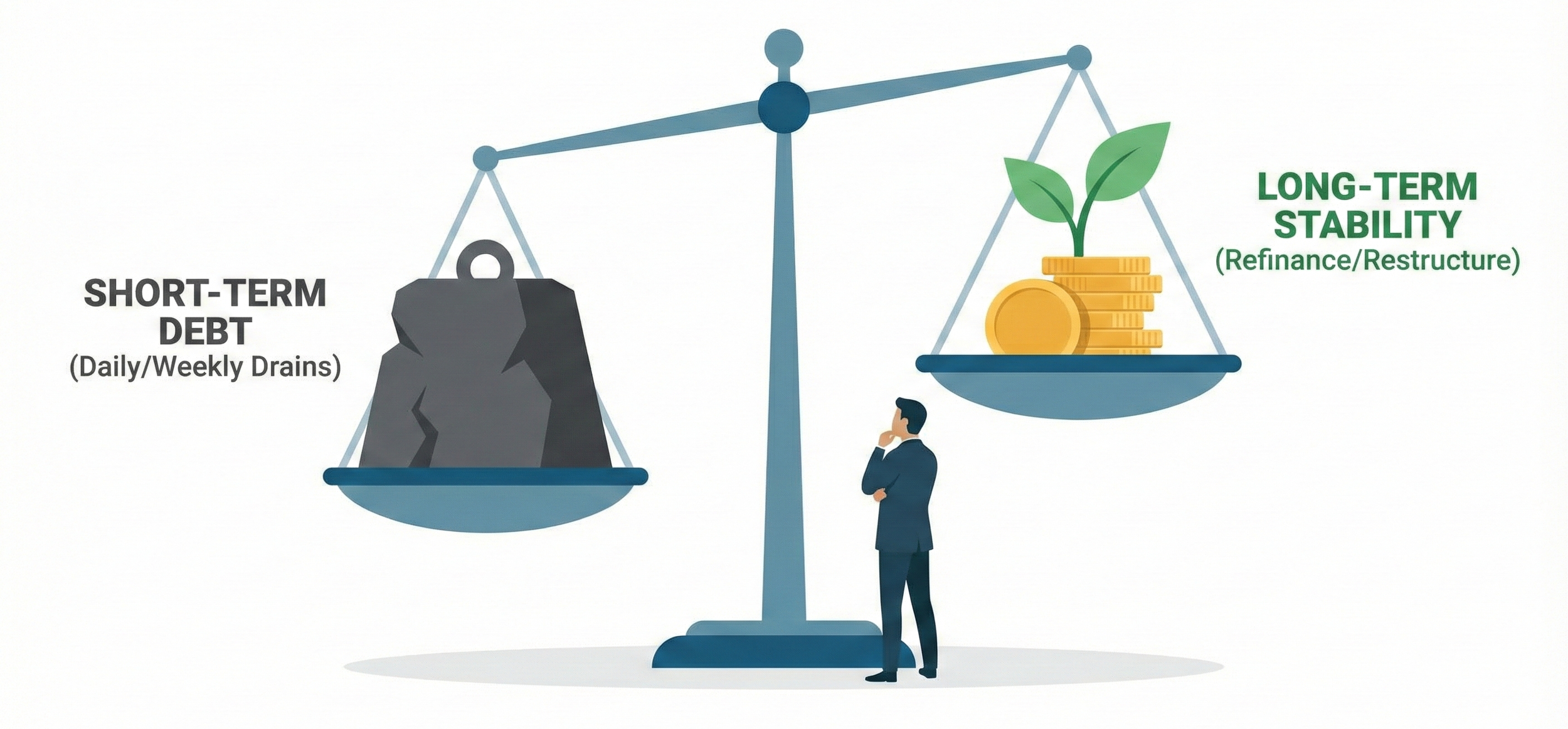General Requirements (takes about 5-minutes or less to apply online)
680+ FICO score (Transunion or Experian FICO model 8.0 or similar)
Less than 15% operating loss in the last year of business
Last 2-Years of filed Business Tax Returns; Last 1-Year of filed Personal Tax Returns
Last 3-months of bank statements; copy of Driver’s License
Business Cash Flow Strain:
Root Causes and Rapid Resolutions
For small business owners, the ability to manage cash flow effectively can mean the difference between thriving and merely surviving.
In today’s fast-paced business environment, cash flow strain is one of the most common and dangerous challenges faced by entrepreneurs.
It can sneak up unexpectedly, triggered by factors both within and outside your control, and if left unaddressed, it can threaten the very existence of your business.
This article is designed to help small business owners understand the root causes of cash flow strain and, more importantly, how to resolve these issues quickly and sustainably.
Through real-world insights, actionable strategies, and practical tools, you’ll gain a comprehensive understanding of how to keep your business financially healthy and resilient.
Understanding Cash Flow:
More Than Just Money In and Out
At its core, cash flow refers to the movement of money into and out of your business.
Positive cash flow means your business is bringing in more money than it’s spending, while negative cash flow indicates the opposite.
However, cash flow is not just about tracking dollars and cents—it’s about timing, predictability, and the ability to meet obligations as they arise.
Many small business owners confuse cash flow with profit.
While profit is the difference between revenue and expenses, cash flow focuses on when money actually enters and leaves your bank account.
A business can be profitable on paper but still face cash flow problems if payments are delayed or expenses come due unexpectedly.
Key components of cash flow include:
Operating cash flow: Money generated from core business operations.
Investing cash flow: Cash used for investments in equipment, property, or other assets.
Financing cash flow: Funds raised through loans, investors, or other financing activities.
Understanding these components is essential for diagnosing and addressing cash flow strain.
Root Causes of Cash Flow Strain
Cash flow strain rarely occurs in isolation. It’s usually the result of several underlying issues that, when combined, create financial pressure. Some of the most common root causes include:
Slow Paying Customers
When clients delay payments, your business may struggle to cover its own expenses. Extended payment terms or late payments can quickly deplete your available cash.
Inventory Mismanagement
Holding too much inventory ties up cash that could be used elsewhere. Conversely, running out of stock can lead to lost sales and dissatisfied customers.
Overhead Creep
As businesses grow, so do their expenses. Unchecked overhead costs—such as rent, utilities, and administrative salaries—can erode cash reserves.
Poor Pricing Strategies
Setting prices too low in an attempt to attract customers can result in insufficient cash to cover costs, while frequent discounting can undermine profitability.
Seasonal Fluctuations
Many businesses experience seasonal highs and lows. Without proper planning, slow periods can create cash flow gaps that are difficult to bridge.
Rapid Growth
While growth is generally positive, expanding too quickly can strain resources. Increased sales often mean higher expenses for inventory, staff, and equipment before additional revenue is realized.
Unexpected Expenses
Emergencies such as equipment breakdowns, legal issues, or economic downturns can drain cash reserves and disrupt normal operations.
Diagnosing Your
Cash Flow ISSUES
Before you can resolve cash flow strain, you need to identify its specific causes within your business.
Start by conducting a thorough cash flow analysis.
This involves reviewing your financial statements, tracking the timing of incoming and outgoing payments, and identifying patterns or anomalies.
Bernarsky Advisors provides cash flow analysis free of charge as we perform business debt service and cash flow analysis of the previous 12-months prior to engaging with clients.
Setup a consultation meeting with a Business Finance & Strategy Advisor to get a review.
Questions to consider during your analysis:
Are there recurring periods when cash flow is tight?
Which customers consistently pay late?
Are certain expenses increasing faster than revenue?
How much cash is tied up in inventory or accounts receivable?
Are there one-off events or trends impacting your cash flow?
Modern accounting software can help automate this analysis, providing real-time insights into your cash position.
However, it’s important to supplement digital tools with your own observations and knowledge of your business’s unique rhythms.
Rapid Resolutions:
Immediate Actions to Relieve Cash Flow Strain
When cash flow problems arise, time is of the essence.
Here are practical steps you can take to address cash flow strain quickly:
Tighten Up Receivables
Invoice promptly: Send invoices as soon as work is completed or goods are delivered.
Follow up: Implement a system for following up on overdue invoices.
Offer incentives: Encourage early payments with small discounts or other perks.
Enforce penalties: Charge late fees for overdue payments where appropriate.
Control Payables
Negotiate terms: Ask suppliers for extended payment terms or installment plans.
Prioritize payments: Pay essential bills first and defer non-critical expenses.
Consolidate vendors: Streamline purchasing to negotiate better rates and terms.
Manage Inventory
Reduce excess stock: Sell off slow-moving inventory, even at a discount, to free up cash.
Adopt just-in-time practices: Order inventory only as needed to minimize cash tied up in stock.
Cut Non-Essential Expenses
Review subscriptions and services: Cancel or downgrade unused services.
Delay non-urgent investments: Postpone purchases that are not immediately necessary.
Access Short-Term Financing
Business lines of credit: Use a line of credit for short-term cash needs.
Invoice factoring: Sell outstanding invoices to a factoring company for immediate cash.
Merchant cash advances: Obtain an advance based on future revenue.
MUST USE THIS OPTION CAUTIOUSLY and have a clear plan to repay the debt
Long-Term Strategies for
Sustainable Cash Flow
Addressing immediate cash flow issues is critical, but long-term health requires strategic planning. Consider these approaches:
Improve Forecasting
Develop cash flow projections: Regularly update forecasts based on sales, expenses, and anticipated changes.
Scenario planning: Prepare for best-case, worst-case, and most likely scenarios.
Strengthen Customer Relationships
Set clear payment expectations: Communicate payment terms upfront and reinforce them in contracts.
Build loyalty: Reliable, satisfied customers are more likely to pay on time.
Diversify Revenue Streams
Expand product or service offerings: Reduce reliance on a single source of income.
Explore new markets: Reach new customer segments to stabilize revenue.
Build a Cash Reserve
Set aside profits: Allocate a portion of profits to a reserve fund for emergencies.
Automate savings: Use automatic transfers to build your reserve consistently.
Monitor Key Metrics
Track days sales outstanding (DSO): Measure how long it takes to collect payments.
Monitor inventory turnover: Ensure stock is moving efficiently.
Review gross and net profit margins: Identify areas for improvement.
General Requirements (takes about 5-minutes or less to apply online)
680+ FICO score (Transunion or Experian FICO model 8.0 or similar)
Less than 15% operating loss in the last year of business
Last 2-Years of filed Business Tax Returns; Last 1-Year of filed Personal Tax Returns
Last 3-months of bank statements; copy of Driver’s License
The Role of Technology in
Cash Flow Management
Modern technology offers powerful tools for managing cash flow more effectively.
Small business owners can leverage a range of software solutions to automate processes, gain insights, and reduce manual errors.
Key benefits of using technology include:
Automated invoicing and payment reminders: Reduce the risk of late payments.
Real-time dashboards: Monitor cash flow status at a glance.
Expense tracking: Identify and control spending patterns.
Integration with bank accounts: Streamline reconciliations and forecasting.
Cloud-based accounting platforms, inventory management tools, and payment processing solutions can all contribute to a healthier cash flow.
When selecting technology, prioritize systems that integrate seamlessly with your existing processes and offer robust support.
Building Strong Relationships
with Lenders and Investors
Access to external funding can be a lifeline during periods of cash flow strain.
Building strong relationships with lenders, investors, and financial partners increases your chances of securing favorable terms when you need them most.
Tips for strengthening these relationships include:
Maintain transparency: Share regular updates on your business’s financial health.
Demonstrate responsibility: Show a track record of prudent financial management.
Prepare documentation: Keep financial statements, tax returns, and business plans up to date.
Explore alternative funding: Consider options such as crowdfunding, peer-to-peer lending, or grants.
Proactive communication and preparation can make the difference between a timely loan approval and a missed opportunity.
Navigating Cash Flow Challenges
During Economic Uncertainty
Economic downturns, industry disruptions, and global events can all impact cash flow in ways that are difficult to predict. Small business owners must be agile and prepared to adapt quickly.
Strategies for navigating uncertainty include:
Maintain flexibility: Be willing to adjust pricing, offerings, or business models as needed.
Strengthen supplier relationships: Reliable suppliers may offer better terms or flexibility during tough times.
Monitor market trends: Stay informed about changes in customer behavior, regulations, and competitor actions.
Revisit contingency plans: Update your crisis management strategies regularly.
Resilience is built through preparation, adaptability, and a willingness to make tough decisions when necessary.
Common Cash Flow
Myths and Misconceptions
Misunderstandings about cash flow can lead to costly mistakes.
Let’s debunk some of the most common myths:
Myth: Profitability guarantees positive cash flow.
Reality: You can be profitable on paper but still run out of cash if payments are delayed or expenses spike unexpectedly.Myth: More sales automatically improve cash flow.
Reality: Rapid sales growth can actually strain cash flow if you need to invest in inventory, staff, or equipment before receiving payment.Myth: Only struggling businesses face cash flow problems.
Reality: Even successful businesses can experience cash flow strain due to external factors or poor planning.Myth: Cash flow management is only about cutting costs.
Reality: While controlling expenses is important, effective cash flow management also involves optimizing revenue, collections, and investment.
Understanding the realities of cash flow helps business owners make informed decisions and avoid pitfalls.
Creating a Cash Flow Resilient Business:
A Step-by-Step Action Plan
Building a business that can withstand cash flow challenges requires proactive planning and consistent action. Here’s a step-by-step plan to strengthen your cash flow resilience:
Step 1: Assess Your Current Position
Review financial statements and cash flow reports.
Identify patterns, bottlenecks, and areas of concern.
Step 2: Set Clear Goals
Define what healthy cash flow looks like for your business.
Establish targets for reserves, DSO, and inventory turnover.
Step 3: Implement Immediate Fixes
Address overdue receivables and cut non-essential expenses.
Negotiate with suppliers and explore short-term financing.
Step 4: Develop Long-Term Strategies
Invest in forecasting tools and technology.
Diversify revenue streams and build customer loyalty.
Step 5: Monitor and Adjust
Regularly review key metrics and update your action plan.
Stay informed about market trends and adjust strategies as needed.
By following this plan and remaining vigilant, you can navigate cash flow challenges with confidence and position your business for long-term success.
Turning Cash Flow Strain
into Opportunity
Cash flow strain is a reality for many small businesses, but it doesn’t have to spell disaster.
By understanding the root causes, taking rapid action, and implementing sustainable strategies, you can not only resolve cash flow issues but also build a stronger, more resilient business.
Remember, cash flow management is an ongoing process.
Stay proactive, leverage technology, and don’t hesitate to seek help from financial professionals when needed.
With the right approach, you can transform cash flow strain into an opportunity for growth, innovation, and lasting success.
Empower your business by mastering cash flow, and you’ll be prepared to weather any storm and seize every opportunity that comes your way.
WHAT IS THE BEST AND SAFEST WAY FOR YOUR BUSINESS TO DEAL WITH HIGH BUSINESS DEBT PAYMENTS?
It is NOT by stopping ACH payments.
It is NOT by taking on another business loan.
It is NOT ALWAYS a Refinancing
It is NOT by entering into a debt settlement program.
Find out the BEST strategies to get your Business back to where it was



















